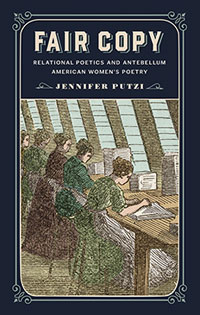Letters obsessing about an alleged stolen poem piqued Jennifer Putzi’s curiosity so much she had to find out more.
She ended up writing an entirely separate book in addition to the one she originally was working on.
Putzi, professor of English and gender, sexuality and women’s studies at William & Mary and director of GSWS, was co-editing a volume of the letters of writer Elizabeth Stoddard when she ran across the controversy involving a poem by Elizabeth Akers Allen. After delving further into the topic, she decided to focus her next project on how working-class women and African American women poets accessed print in the early 19th century U.S.
The result is a look at five individual women poets and the composition, publication and circulation of American women’s poetry in the antebellum U.S. Putzi’s new book, “Fair Copy: Relational Poetics and Antebellum American Women Poets,” was published in the fall by the University of Pennsylvania Press.

Putzi’s unusual approach takes the emphasis away from the content of the individual poems or success attained by each poet and puts it instead on the broader context in which the poems were written, published and circulated to the reading public.
“Even though I’m saying that I’m not focusing on authors with a capital A, I am interested in women who wrote poems and in women’s stories,” Putzi said. “I am interested in how Maria James, who’s a domestic servant, came to write a poem that people cared about, how Elizabeth Akers Allen fought for her reputation.
“I feel like there’s a way sort of circuitously to come back around to the author, even though I’m saying the author isn’t all that matters. There’s all these other relationships — what I’m calling relational poetics — and all these other elements in the publication of a poem that matter.”
Putzi was editing the Stoddard letters when she ran across the letters in which Akers Allen and Stoddard discussed the man accused of stealing the poem “Rock Me To Sleep” that Akers Allen wrote and had published in 1859. It was so popular that numerous people claimed to have written it, according to Putzi.
“That just surprised me,” Putzi said. “I had never thought about poetry in that way. That people would actually care enough not to just say that they had written a poem, not to just make that claim, but to fiercely make it.
“People were going to the newspapers and saying they had written it; this guy published a pamphlet. And Akers Allen went to great lengths to try to prove her authorship.”
This led Putzi to start thinking about poetry and authorship differently and to examining how people of that time period viewed ownership of poetry.
“Everybody read poetry in the 19th century, which led to them consuming it in a very different way,” Putzi said.
People read poetry daily in newspapers, and it was in every magazine, with people commonly writing and reading poetry, she said.
“From there I just started thinking about women’s authorship of poetry and how maybe it was different from men’s authorship of poetry, and what it meant to write a poem and to publish a poem and to read a poem in the 19th century,” Putzi said.
The contextual details for each poet in the book led to a deeper and different reading of the actual poetry, which at first glance can appear pedestrian. Understanding print culture, authorship and reading the poems in the places they were published leads to better understanding of why they were written in the way that they were, according to Putzi.
For example, looking at why abolitionist African American poet Sarah Forten is publishing her poems in the Liberator, what sorts of discourses she’s using in her poetry and what she’s speaking to makes her poetry more interesting. Tracking how working-class poets got their work published is an important component.
“We can’t expect these writers to have written a poem that (Ralph Waldo) Emerson writes,” Putzi said. “And I don’t mean aesthetically or quality-wise; it’s just that they’re writing in very different contexts for very different audiences. They’re forming different kinds of relationships through poetry and in order to publish poetry. And I’m interested in how that shapes the poems that these women publish.”
Finding traces of the little-known poets was a big research challenge in some cases. Maria James, a Welsh immigrant who worked as a domestic servant, was one such obscure poet who published a book with the help of her employers and other benefactors. Putzi only was able to find the papers of James’ employer, Mary Rutherford Garretson, which included letters between Garretson and the minister who edited and wrote the preface for her book.
Poet Lydia Sigourney, the subject of one of the chapters, has received more attention, and Putzi regularly teaches about her. But she hopes her work opens the door to more study of other women poets
“We’re always lamenting there are no 19th century African American women poets, no working-class American women poets,” Putzi said. “And there were. We just don’t know how to read them. We don’t know how to pay attention to their work. So I hope this opens that up and brings attention to more writers.”
Jennifer L. Williams, Communications Specialist

